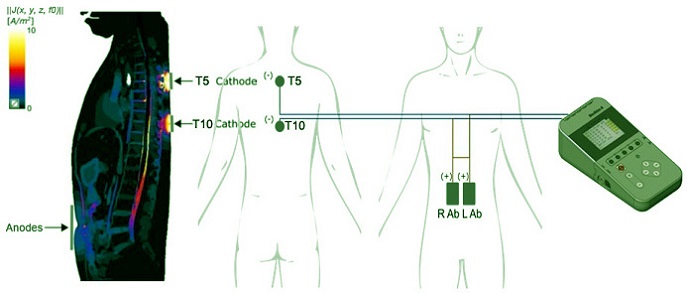Nikhil Prasad Fact checked by:Thailand Medical News Team Nov 20, 2024 5 months, 5 days, 1 hour, 4 minutes ago
Medical News: As COVID-19 continues to leave lasting effects on health, researchers from the University of Louisville, Kentucky, USA, and Pavlov Institute of Physiology, St. Petersburg, Russia, have developed an innovative therapy for respiratory recovery. They explored how spinal cord transcutaneous stimulation (scTS) combined with respiratory training (RT) can improve lung function in patients suffering from post-acute COVID-19 syndrome.
 Placement of the scTS electrodes and sagittal view of the current field density using computational modeling carried out ohmic quasi-static simulations (Sim4Life, Zurich Med Tech, Switzerland) in a virtual model (Yoon Sun ViP 4.0, IT’IS Foundation) with tissue-specific electrical properties. Note that cathodes (−) are positioned on the skin between the Th3–Th4 and Th8–Th9 spinous processes, aligning with the T5 and T10 spinal cord segments, respectively; the anodes (+) are located over the abdomen (Ab), horizontally centered at the level of the umbilicus.
Placement of the scTS electrodes and sagittal view of the current field density using computational modeling carried out ohmic quasi-static simulations (Sim4Life, Zurich Med Tech, Switzerland) in a virtual model (Yoon Sun ViP 4.0, IT’IS Foundation) with tissue-specific electrical properties. Note that cathodes (−) are positioned on the skin between the Th3–Th4 and Th8–Th9 spinous processes, aligning with the T5 and T10 spinal cord segments, respectively; the anodes (+) are located over the abdomen (Ab), horizontally centered at the level of the umbilicus.
This
Medical News report dives into the groundbreaking study conducted on five participants, each of whom had experienced severe COVID-19 with significant respiratory complications. Unlike traditional rehabilitation, which focuses on respiratory training alone, the integration of neuromodulation showed enhanced outcomes in breathing performance.
The Challenge of Post-COVID Respiratory Recovery
Many survivors of severe COVID-19 report lingering respiratory symptoms like shortness of breath and fatigue. Traditional therapies often fail to fully restore lung capacity. The new study aimed to address these issues by combining conventional RT with scTS, which stimulates the neural networks controlling respiratory muscles. This dual approach targets both the mechanical and neurological components of breathing.
The study participants underwent two phases of intervention. First, they received ten daily sessions of RT, focusing on strengthening respiratory muscles through controlled breathing exercises. The second phase introduced scTS in addition to RT, applying electrical stimulation to specific areas of the spinal cord associated with respiratory control.
Promising Results from Combined Therapy
The findings were remarkable. When RT was used alone, improvements in forced vital capacity (FVC) and other measures of lung function were minimal. However, the addition of scTS resulted in significant gains. Key outcomes included:
-Forced Vital Capacity (FVC): Increased from 2.28 liters to 2.99 liters, marking a 31% improvement.
-Peak Expiratory Flow (PEF): Improved from 1.52 liters per second to 2.11 liters per second, a substantial boost in the ability to exhale forcefully.
-Time to Peak Expiratory Flow (tPEF): Reduced significantly, indicating faster and more efficient breathing.
These results suggest that scTS not only strengthens respiratory muscles but also activates the neural pathway
s that control them. This combined effect enhances overall lung function and breathing efficiency.
How Does Spinal Cord Stimulation Work?
Spinal cord transcutaneous stimulation delivers electrical pulses to the spinal cord, targeting the neural circuits involved in respiratory control. In this study, the stimulation was applied non-invasively using electrodes placed on the back and abdomen. By increasing the excitability of motor neurons, scTS enhances the response of respiratory muscles during training.
The researchers found that scTS helped retrain the brain and spinal cord to work more efficiently together, amplifying the effects of traditional respiratory exercises. This neuromodulatory effect promotes neural plasticity, which is the nervous system’s ability to adapt and recover after injury or illness.
Study Design and Methodology
The study included five adults, aged 34 to 76, who had been hospitalized for severe COVID-19. All participants experienced at least a 20% reduction in predicted FVC, indicating significant respiratory impairment. After recovering from the acute phase of the illness, they were enrolled in a rehabilitation program spanning 20 days.
The first 10 days focused solely on RT, where participants used a device to perform controlled expiratory efforts. In the following 10 days, scTS was added to the regimen. The researchers monitored several parameters, including FVC, PEF, and the time to reach peak inspiratory and expiratory flow.
Expanding the Potential of Neuromodulation
The study highlights the potential of scTS as a game-changer in respiratory rehabilitation. While RT alone showed medium-level effectiveness, the addition of scTS nearly doubled the average effect size across all outcomes. This suggests that neuromodulation could become a standard component of rehabilitation for post-COVID respiratory deficits.
Moreover, the findings open doors for applying scTS to other conditions that involve respiratory dysfunction, such as chronic obstructive pulmonary disease (COPD) and neurological disorders. As researchers refine stimulation protocols and explore new applications, the technology could benefit a wide range of patients.
Conclusion
The combination of spinal cord stimulation and respiratory training offers a groundbreaking approach to respiratory rehabilitation, particularly for those struggling with post-COVID complications. By targeting both the physical and neurological aspects of breathing, this therapy provides a more comprehensive solution for improving lung function and quality of life.
As the need for effective post-COVID care continues to grow, innovations like this are paving the way for better outcomes.
The study findings were published in the peer-reviewed journal: Life.
https://www.mdpi.com/2075-1729/14/11/1518
For the latest COVID-19 News, keep on logging to Thailand
Medical News.
Read Also:
https://www.thailandmedical.news/news/covid-19-diaphragm-weakness-persists-2-years-later-but-shows-improvement-with-muscle-training
https://www.thailandmedical.news/news/doctors-warn-that-most-exposed-to-covid-19-have-dysfunctional-lung-gas-exchange
